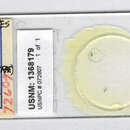fr
noms dans le fil d’Ariane


Opecoelidae is a family of trematodes. It is the largest digenean family with over 90 genera and nearly 900 species, almost solely found in marine and freshwater teleost fishes.[2] It was considered by Bray et al. to belong in the superfamily Opecoeloidea Ozaki, 1925 or the Brachycladioidea Odhner, 1905.[2]
Family Opecoelidae
Opecoelidae is a family of trematodes. It is the largest digenean family with over 90 genera and nearly 900 species, almost solely found in marine and freshwater teleost fishes. It was considered by Bray et al. to belong in the superfamily Opecoeloidea Ozaki, 1925 or the Brachycladioidea Odhner, 1905.
孔腸科(學名: Opecoelidae)是斜睪目之下一個吸蟲綱複殖亞綱寄生蟲的科[2],是複殖亞綱之下物種最豐盛的一個科,包含有近100個屬、接近900個物種。這上千種物種全在淡水和鹹水生活的真骨類支序魚類身上寄生[3]。
本科在WoRMS屬於Allocreadioidea總科,但在Bray et al.被劃為獨立一個總科 Opecoeloidea Ozaki, 1925 ,又或屬於 Brachycladioidea Odhner, 1905[3]。
本科物種尚可分為多個亞科,分別如下:
孔腸科(學名: Opecoelidae)是斜睪目之下一個吸蟲綱複殖亞綱寄生蟲的科,是複殖亞綱之下物種最豐盛的一個科,包含有近100個屬、接近900個物種。這上千種物種全在淡水和鹹水生活的真骨類支序魚類身上寄生。